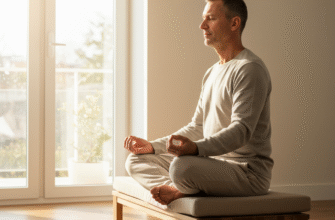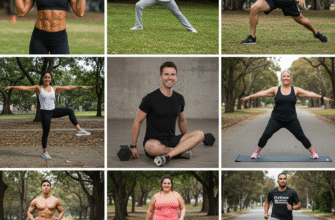Pushing your limits in the gym feels great. That burn, the sweat, the feeling of accomplishment after a tough workout – it’s addictive. Many people get caught up in the idea that more is always better when it comes to building muscle. They grind day after day, terrified that taking a day off means losing hard-earned gains. But here’s the thing: constantly hammering your muscles without adequate recovery is actually one of the biggest mistakes you can make if your goal is growth and strength.
Think about it: exercise, especially resistance training, isn’t the direct cause of muscle growth. It’s the stimulus. When you lift weights or challenge your muscles, you create microscopic tears in the muscle fibers. This sounds bad, but it’s a necessary part of the process. This damage triggers an inflammatory response and signals your body that repairs are needed. It’s during the period after your workout, when you’re resting, that the real magic happens.
The Science of Recovery: Building Back Stronger
Your body is incredibly adaptive. When it detects the micro-damage caused by exercise, it doesn’t just repair the fibers back to their original state. It overcompensates, rebuilding them slightly thicker and stronger to better handle similar stress in the future. This process is known as muscle protein synthesis (MPS). For MPS to occur effectively, several things need to happen, and they predominantly happen during rest:
- Repair Time: The muscle fibers need time free from intense stress to actually mend. Continuously stressing already damaged fibers hinders this repair process.
- Nutrient Delivery: Rest allows your circulatory system to efficiently deliver nutrients, particularly protein and carbohydrates, to the damaged muscle tissue to fuel repair and glycogen replenishment.
- Hormonal Balance: Crucial muscle-building hormones, like growth hormone, are released primarily during deep sleep. Cortisol, a stress hormone that can break down muscle tissue (catabolism), tends to be higher with excessive training and insufficient rest. Rest helps restore a more favorable anabolic (muscle-building) hormonal environment.
- Central Nervous System (CNS) Recovery: Intense training doesn’t just tax your muscles; it also fatigues your CNS, which is responsible for recruiting muscle fibers. CNS fatigue can lead to decreased strength, coordination, and motivation. Rest days are vital for CNS recovery.
Ignoring Rest: The Path to Overtraining
Skipping rest days consistently can lead to a state known as overtraining syndrome (OTS), or more commonly, non-functional overreaching. This isn’t just about feeling a bit tired; it’s a cascade of negative physiological and psychological effects. Instead of getting stronger, you might find yourself hitting a plateau or even regressing.
Signs that you might be pushing too hard without enough recovery include:
- Persistent muscle soreness that doesn’t subside
- Increased frequency of nagging injuries or new aches and pains
- Decreased performance, strength, or endurance
- Prolonged fatigue and lack of energy, even outside the gym
- Sleep disturbances (difficulty falling asleep or staying asleep)
- Changes in appetite
- Increased irritability, mood swings, or lack of motivation
- More frequent illnesses due to a potentially suppressed immune system
Listen to Your Body. Ignoring the signals of overtraining doesn’t make you tough; it makes you prone to injury and burnout. Consistently pushing through significant fatigue or pain can lead to serious setbacks, hindering your progress far more than a scheduled rest day ever would. Recovery isn’t optional; it’s essential.
How Much Rest Do You Actually Need?
There’s no single magic number for rest days that applies to everyone. The optimal amount of rest depends on various individual factors:
- Training Intensity and Volume: Heavier lifting sessions targeting large muscle groups generally require more recovery time than lighter workouts or isolation exercises. Higher volume (more sets and reps) also increases recovery demands.
- Training Experience: Beginners often recover faster from moderate workouts than highly trained athletes pushing their absolute limits. However, beginners also need to be cautious not to do too much too soon.
- Age: Recovery processes tend to slow down naturally with age. Older individuals might benefit from incorporating more rest days.
- Nutrition and Hydration: Proper intake of protein, carbohydrates, and overall calories, along with adequate hydration, significantly supports recovery. Poor nutrition hinders it.
- Sleep Quality and Quantity: Sleep is prime recovery time. Consistently poor sleep (less than 7-8 hours for most adults) will impair muscle repair and growth, necessitating more rest.
- Overall Life Stress: Stress from work, relationships, or other sources elevates cortisol, which can interfere with recovery. High life stress might mean you need more downtime.
A common recommendation is to take at least one to two full rest days per week. Some training splits naturally build in rest (e.g., training upper body one day, lower body the next, then rest). Others might train 3-4 days a week with rest days in between. The key is listening to your body’s feedback rather than rigidly adhering to a schedule that isn’t working for you.
Active Recovery vs. Complete Rest
Rest days don’t necessarily mean lying on the couch all day (though sometimes, that’s exactly what’s needed!). There’s a difference between passive rest (minimal activity) and active recovery.
Active recovery involves light, low-intensity activities performed on rest days. Think:
- Gentle walking
- Light cycling
- Swimming
- Foam rolling
- Stretching or yoga
The goal of active recovery is to promote blood flow to the muscles without causing further stress or damage. This enhanced circulation can help flush out metabolic byproducts and deliver nutrients, potentially reducing soreness and speeding up recovery for some individuals. It keeps you moving without hindering the repair process.
Passive rest involves minimizing physical activity. This is crucial when you’re feeling genuinely fatigued, sore, or rundown. Sometimes, giving your body and nervous system a complete break is the most effective approach.
Making the Most of Your Rest Days
Treat your rest days with the same importance as your training days. They are an active part of your muscle-building strategy. Focus on:
- Nutrition: Don’t drastically cut calories on rest days. Your body still needs fuel, especially protein, to repair and build muscle tissue. Keep protein intake consistent. Ensure adequate carbohydrate intake to replenish glycogen stores.
- Hydration: Stay well-hydrated to support cellular function and nutrient transport.
- Sleep: Prioritize getting 7-9 hours of quality sleep. This is when growth hormone release peaks and muscle repair is most active.
- Stress Management: Engage in relaxing activities to lower cortisol levels.
- Listen In: Pay attention to how your body feels. Are you recovering well? Do you feel energized for your next workout? Adjust your rest schedule based on this feedback.
Ultimately, building muscle is a cycle of stimulus (training) and adaptation (recovery). Neglecting the recovery phase means you’re only getting half the equation right. Embrace rest days not as a sign of weakness or lost time, but as a strategic, essential component of getting stronger, bigger, and reaching your fitness goals faster and more sustainably. Your muscles will thank you for it.








